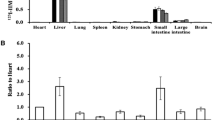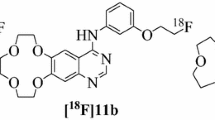Abstract
The expression of thymidine phosphorylase (TP) is closely associated with angiogenesis, tumor invasiveness, and activation of antitumor agents. We developed a radiolabeled uracil derivative, I-123-labeled 5-iodo-6-[(2-iminoimidazolidinyl)methyl]uracil ([123I]IIMU), as a novel SPECT probe for TP. A clinical study to verify the safety of [123I]IIMU injection was approved by the Institutional Review Board of Hokkaido University Hospital for Clinical Research, and first-in-human (FIH) clinical studies of healthy adults were started.
Here, we will introduce our research, including the synthesis of [123I]IIMU and its efficacy and safety evaluation, toward its FIH clinical study.
-
Radiosynthesis of [ 123 I]IIMU: [123I]IIMU synthesis was achieved by radioiodination of the precursor
,6-(2-iminoimidazolidinyl)methyluracil at the C-5 position with N-chlorosuccinimide/[123I]NaI. After purification by HPLC, [123I]IIMU was obtained in high radiochemical yields. -
In vitro and in vivo studies: The in vitro and in vivo uptake of [125I]IIMU by the A431 tumor was attributable to the binding of the radiotracer to its target enzyme, i.e., TP. SPECT/CT imaging with [123I]IIMU clearly visualized the A431 tumor 3 h after the injection of n.c.a. [123I]IIMU.
-
Safety assessment: The human radiation absorbed dose was estimated as 17 μSv/MBq on the basis of the biodistribution data of [I]IIMU in normal mice. The no observed adverse effect level (NOAEL) for intravenous administration of non-radiolabeled IIMU to mice was higher than 1.8 mg/kg. The bacterial reverse mutation assay showed negative results.
You have full access to this open access chapter, Download conference paper PDF
Similar content being viewed by others
Keywords
1 Introduction
Thymidine phosphorylase (TP) catalyzes the reversible phosphorolysis of thymidine to thymine and 2-deoxyribose-1-phosphate. The expression of TP is highly associated with angiogenesis, infiltration, and metastasis of tumors. The activity and expression level of TP in many tumors are higher than those in the adjacent nonneoplastic tissues [1].
We developed a radiolabeled uracil derivative, I-123-labeled 5-iodo-6-[(2-iminoimidazolidinyl)methyl]uracil ([123I]IIMU, Fig. 9.1), as a novel SPECT probe for TP. A clinical study to verify the safety of [123I]IIMU injection was approved by the Institutional Review Board of Hokkaido University Hospital for Clinical Research, and first-in-human (FIH) clinical studies on healthy adults were started.
Here, we will introduce our research, including the synthesis of [123I]IIMU [2, 3] and its efficacy [4–6] and safety evaluation, toward its FIH clinical study.
2 Radiosynthesis of [123I]IIMU [2]
[123I]IIMU was synthesized according to a method previously reported [3]. Briefly, dry acetone containing N-chlorosuccinimide/AcOH was added to [123I]NaI (370 MBq) in a reaction vial, and the mixture was allowed to stand for 10 min at room temperature. Acetone was then removed completely under a stream of N2. A solution of 6-[(2-iminoimidazolidinyl)methyl]uracil (HIMU-TFA) in aqueous acetonitrile (CH3CN/H2O = 2:1) was added to the residue, and the capped vial was heated for 35 min at 50 °C. After removal of the solvent, the crude product was converted to [123I]IIMU-HCl and purified simultaneously by reversed-phase HPLC using a solvent system containing HCl. The radioactive fraction was sterilized through a 0.22 μm membrane filter. The radiochemical purity of [123I]IIMU was determined with HPLC. Residual organic solvents were determined with GC. Sterility tests and bacterial endotoxin tests were also performed.
[123I]IIMU for intravenous injection was prepared in 2.5 h with a yield of 205 ± 24 MBq (n = 3). The radiochemical purity of [123I]IIMU was found to be more than 99 % (Table 9.1). The results of the quality control tests are summarized in Table 9.2. Acetone was not detected in the solution. The ethanol concentration was 104 ± 111 ppm. Sterility tests and bacterial endotoxin tests showed negative results (Table 9.2). We successfully prepared [123I]IIMU for intravenous injection with high purity. Results of quality control tests demonstrate that the [123I]IIMU preparation is suitable for clinical studies.
3 In Vitro Study: Uptake of [125I]IIMU in Cultured A431 and AZ521 Cells [4]
Immunoblotting for the detection of TP demonstrated high enzyme expression in A431 human epithelial carcinoma cells and very low expression in AZ521 human gastric cancer cells. A431 or AZ521 cells in 24-well plates were incubated at 37 °C in 1 mL of PBS(−) containing 37 kBq of [125I]IIMU for 10, 30, 60, or 120 min. The incubation solution was removed, and cells were washed and solubilized in 0.7 mL of 0.2 M NaOH. The radioactivity and protein content of the cell lysate were evaluated. When the radiotracer was incubated with A431 cells, the uptake level of the radiotracer increased with an increase in the incubation time, with 5.3 % dose/mg protein at 2 h of incubation. In the case of AZ521 cells, uptake of radioactivity was extremely low, 0.68 % dose/mg protein at most, regardless of incubation time. To confirm whether the observed uptake is due to the binding of the tracer to TP, similar experiments with A431 tumors were conducted in the presence of various concentrations of nonlabeled IIMU. The uptake level of [125I]IIMU in A431 cells was reduced depending on the concentration of nonlabeled IIMU.
4 In Vivo Study: Biodistribution of [125I]IIMU in A431 and AZ521 Tumor-Bearing Nude Mice [4]
The entire experimental protocol was approved by the Laboratory Animal Care and Use Committee of Hokkaido University. A saline solution of [125I]IIMU (37 kBq, 0.1 mL) was injected into the tail vein of A431 or AZ521 tumor-bearing female Balb/cAJc1-nu/nu mice (8 weeks old; about 20 g ). At 0.5, 1, 3, and 24 h after administration, animals were euthanized and the organs of interest and blood were collected. Radioactivity levels in the blood and muscle were similar in A431 and AZ521 tumor-bearing mice. However, tumor accumulation levels were markedly different between the two; the A431 tumor with high TP expression showed high accumulation, while AZ521 tumor with low TP expression showed low accumulation. To hamper the binding of the tracer to TP, an excess amount of non-radiolabeled IIMU was administered to A431 tumor-bearing mice and the biodistribution was evaluated at 0.5 h postinjection. The radioactivity in A431 tumor was reduced by co-injection of nonlabeled IIMU.
The in vitro and in vivo uptake of [125I]IIMU by the A431 tumor was attributable to the binding of the radiotracer to its target enzyme, i.e., TP.
5 SPECT/CT Imaging Study [2]
Small-animal SPECT imaging studies were performed in mice bearing A431 xenografts after intravenous injection of non-carrier-added (n.c.a.) [123I]IIMU or [123I]IIMU with an excessively large amount of nonlabeled IIMU (n = 3 per group) by using a small-animal PET/SPECT/CT. SPECT/CT imaging with [123I]IIMU clearly visualized A431 tumor 3 h after the injection of n.c.a. [123I]IIMU (Fig. 9.2a). The accumulation of [123I]IIMU in the tumor and liver was inhibited by the co-injection of non-radiolabeled IIMU (Fig. 9.2b).
6 Safety Assessment
To realize the application of [123I]IIMU to clinical studies, we performed safety assessment of [123I]IIMU. Evaluation of radiation absorbed dose is important for the safety assessment of radiopharmaceuticals. The human radiation absorbed dose was estimated as 17 μSv/MBq on the basis of the biodistribution data of [125I]IIMU in normal mice. The highest radiation dose was of the urinary bladder (130 μGy/MBq), followed by the liver (75.1 μGy/MBq), thyroid (47.3 μGy/MBq), and gallbladder (20.4 μGy/MBq). The human radiation absorbed dose of [123I]IIMU was considered to be within the allowable range and is equal to or less than the human radiation absorbed dose of [18F]FDG (21 μSv/MBq; ICPR 60).
Also, based on the “guidance for conducting microdose clinical trials,” we performed an extended single-dose toxicity study and the bacterial reverse mutation assay (Ames test). In the extended single-dose toxicity study, SD rats were given a single intravenous dose (0, 0.18, and 1.8 mg/kg) on Day 1, followed by observations until termination on Day 14. There were no deaths or in-life clinical signs and there were no microscopic effects. The no observed adverse effect level (NOAEL) for intravenous administration of nonlabeled IIMU to mice was greater than 1.8 mg/kg. The bacterial reverse mutation assay showed negative results.
7 Conclusions
Our findings indicate that [123I]IIMU should be developed as a diagnostic agent for imaging TP-expressing tumors. It was shown that [123I]IIMU injection can be safely administered in preclinical studies. Examinations using [123I]IIMU for injection are expected to provide useful information that is difficult to obtain by other conventional methods, such as estimation/determination of therapeutic effects of anticancer drugs, decision-making for a treatment plan, prognostic prediction, understanding of disease stages, and malignancy assessment.
References
Takebayashi Y, Yamada K, Miyadera K, et al. The activity and expression of thymidine phosphorylase in human solid tumors. Eur J Cancer. 1996;32A:1227–32.
Nishijima K, Zhao S, Zhao Y, et al. Preparation and evaluation of [123I]IIMU for SPECT imaging of thymidine phosphorylase expression in tumors. J Label Compd Radiopharm. 2013;56:S1–S349.
Takahashi M, Seki K, Nishijima K, et al. Synthesis of a radioiodinated thymidine phosphorylase inhibitor and its preliminary evaluation as a potential SPECT tracer for angiogenic enzyme expression. J Label Compd Radiopharm. 2008;51:384–7.
Akizawa H, Zhao S, Takahashi M, et al. In vitro and in vivo evaluations of a radioiodinated thymidine phosphorylase inhibitor as a tumor diagnostic agent for angiogenic enzyme imaging. Nucl Med Biol. 2010;37:427–32.
Li H, Zhao S, Jin Y, et al. Radiolabeled uracil derivative as a novel SPECT probe for thymidine phosphorylase: suppressed accumulation into tumor cells by target gene knockdown. Nucl Med Commun. 2011;32:1211–5.
Zhao S, Li H, Nishijima K et al. Relationship between biodistribution of a novel thymidine phosphorylase (TP) imaging probe and TP expression levels in normal mice. Ann Nucl Med. 2015;29:582-7.
Author information
Authors and Affiliations
Corresponding author
Editor information
Editors and Affiliations
Rights and permissions
Open Access This chapter is distributed under the terms of the Creative Commons Attribution-Noncommercial 2.5 License (http://creativecommons.org/licenses/by-nc/2.5/) which permits any noncommercial use, distribution, and reproduction in any medium, provided the original author(s) and source are credited.
The images or other third party material in this chapter are included in the work’s Creative Commons license, unless indicated otherwise in the credit line; if such material is not included in the work’s Creative Commons license and the respective action is not permitted by statutory regulation, users will need to obtain permission from the license holder to duplicate, adapt or reproduce the material.
Copyright information
© 2016 The Author(s)
About this paper
Cite this paper
Nishijima, Ki. et al. (2016). Preclinical Evaluation of a Thymidine Phosphorylase Imaging Probe, [123I]IIMU, for Translational Research. In: Kuge, Y., Shiga, T., Tamaki, N. (eds) Perspectives on Nuclear Medicine for Molecular Diagnosis and Integrated Therapy. Springer, Tokyo. https://doi.org/10.1007/978-4-431-55894-1_9
Download citation
DOI: https://doi.org/10.1007/978-4-431-55894-1_9
Published:
Publisher Name: Springer, Tokyo
Print ISBN: 978-4-431-55892-7
Online ISBN: 978-4-431-55894-1
eBook Packages: MedicineMedicine (R0)






